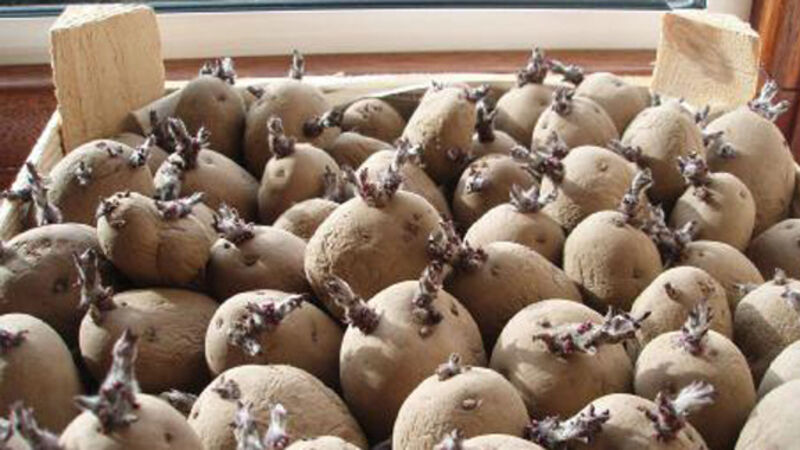It’s time to encourage seed potatoes to sprout

Surprisingly, China is the world’s largest potato producer.
After rice, wheat and maize, potatoes are the number one staple crop in the world. Being one of the most versatile of all vegetables, prevalent to every culture and available all year round, potatoes could potentially pop up at breakfast, brunch, supper, dinner or any given snack time.
As a nation of potato pundits, we are all well accustomed to boiling, baking, roasting, mashing, frying and eating them. Planting, earthing-up and picking is also simple spud speak. But what about chitting potatoes?
Well, one of the first jobs of the vegetable growing season is to chit early potatoes. Chitting simply means encouraging or forcing seed potatoes (tubers), to sprout before planting.
It involves putting seed potatoes somewhere light, cool, but frost-free for several weeks while they form short, sturdy shoots. Be warned that those long, spindly white shoots that spuds put out when abandoned in the back of a dark cupboard, do not constitute chitting.
Firstly, you may ask, why on earth would one bother? Well chitting basically gets potato plants growing earlier which in turn encourages them to produce earlier and sequentially allows homegrowers to harvest earlier and potato lovers to gorge earlier.
After a long winter existing on stored main crop potatoes, the taste of the first early new spuds of the season, with their thin skins and deliciously waxy texture, is eargerly anticipated.
Earlier cropping has the added bonus of getting your first earlies in and out of the ground before the dreaded potato blight becomes a potential problem.
Combined with early planting and protected cropping such as in a polytunnel, glasshouse or cloche, chitting seed potatoes may result in potato harvests, nearly six weeks earlier than usual. There generally is no great advantage to chitting main crop potatoes.
Most good garden centres sell certified seed potatoes and early potatoes should be in stock now. Start chitting from late January or early February.
St Patricks Day is the traditional day for planting first early potatoes outside in Ireland and it is generally advised to start about six weeks before you intend to plant.
Since early spuds come in to shops well in advance, chitting can just be a useful way of keeping them in good condition until the soil warms up.
You will notice that each seed tuber has a more rounded, blunt end known as the ‘rose’ end, containing a number of ‘eyes’.
It is from these ‘eyes’ that shoots develop. Stand the tubers upright with the ‘rose’ end facing up. If you have a greenhouse or a sunny porch or window, this is an ideal location.
Light is very important so don’t shove your chitting spuds off to the back of a dark cold shed. If you only have a few tubers, line them up in old egg cartons but if you are sprouting lots, place them in shallow, open, slatted-bottomed boxes and use folded newspaper or cardboard to create sections and slots to keep the tubers upright. Be sure to cover with a fleece if heavy frost is forecast.
Desired shoots will be strong, short and greenish-purple in colour, unlike the familiar leggy white shoots from a dark cupboard. They should be about ¾ inch to1inch long, from the eyes of each tuber.
To increase the size of your potatoes, rub off all but three or four shoots at the top of the tuber before planting out to encourage large tubers to be harvested early. If you leave all the shoots intact, there is too much competition and you will end up with lots of small potatoes.
Ensure to plant seed potatoes in the ground with the sprouts facing up and be careful not to break the sprouts off while handling.
Like many subjects, chitting potatoes can be a controversial one among gardeners and those of the ‘just bung them in the ground’ school of thought may argue that sprouted potatoes, already in growth, are much more vulnerable to late-Spring frost damage and may have their growth set back by inappropriate soil conditions.
It is certainly true that your spuds will grow, chitted or not. Why not make up your own mind by sprouting some of your first early spuds, leave the others to fend for themselves and compare the difference in date and size of yields.
If you would like to order organic, early seed potatoes online, check out www.fruithillfarm.com . Varieties to chose from include Sharpes Express, Orla and Colleen.












